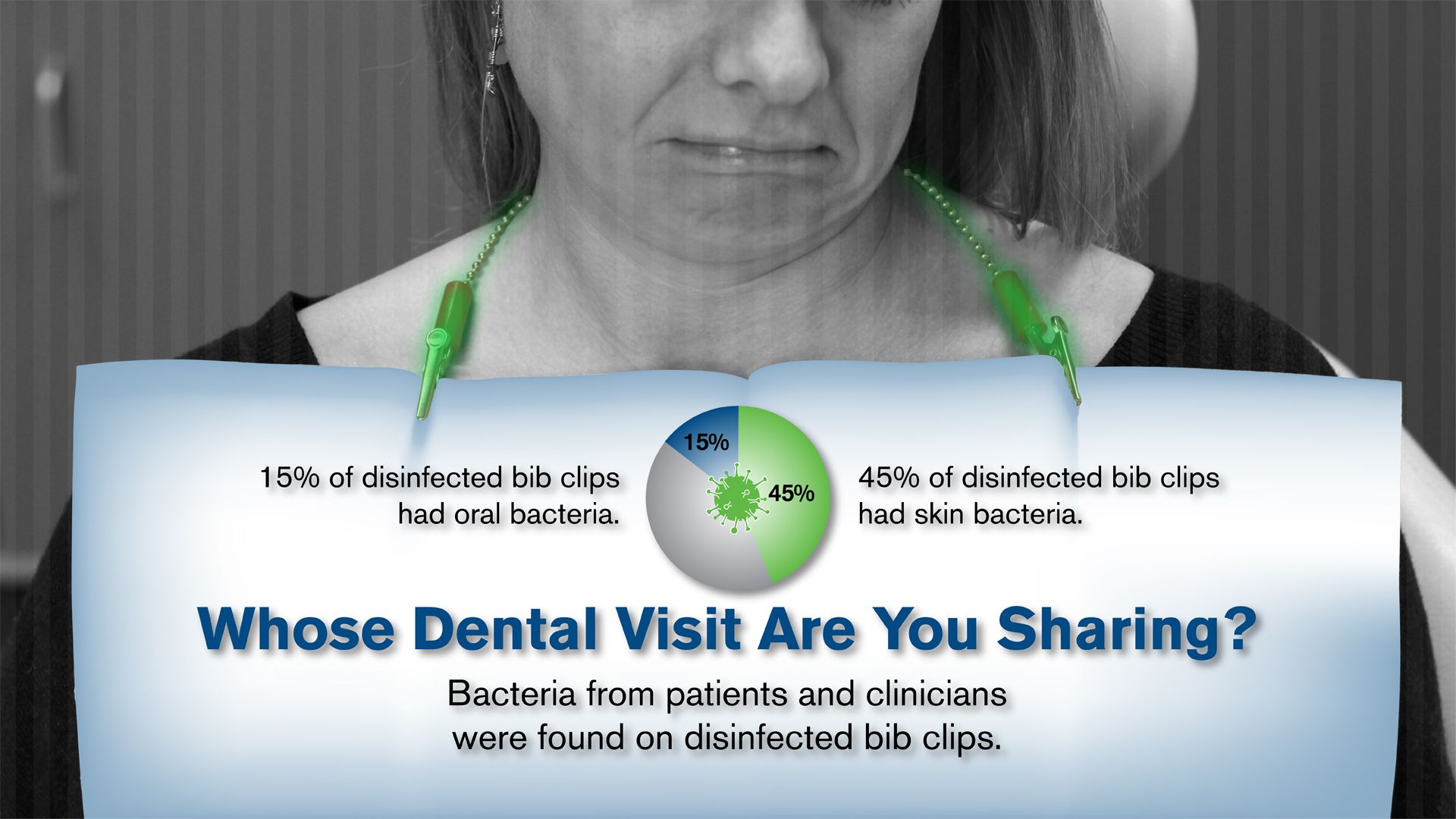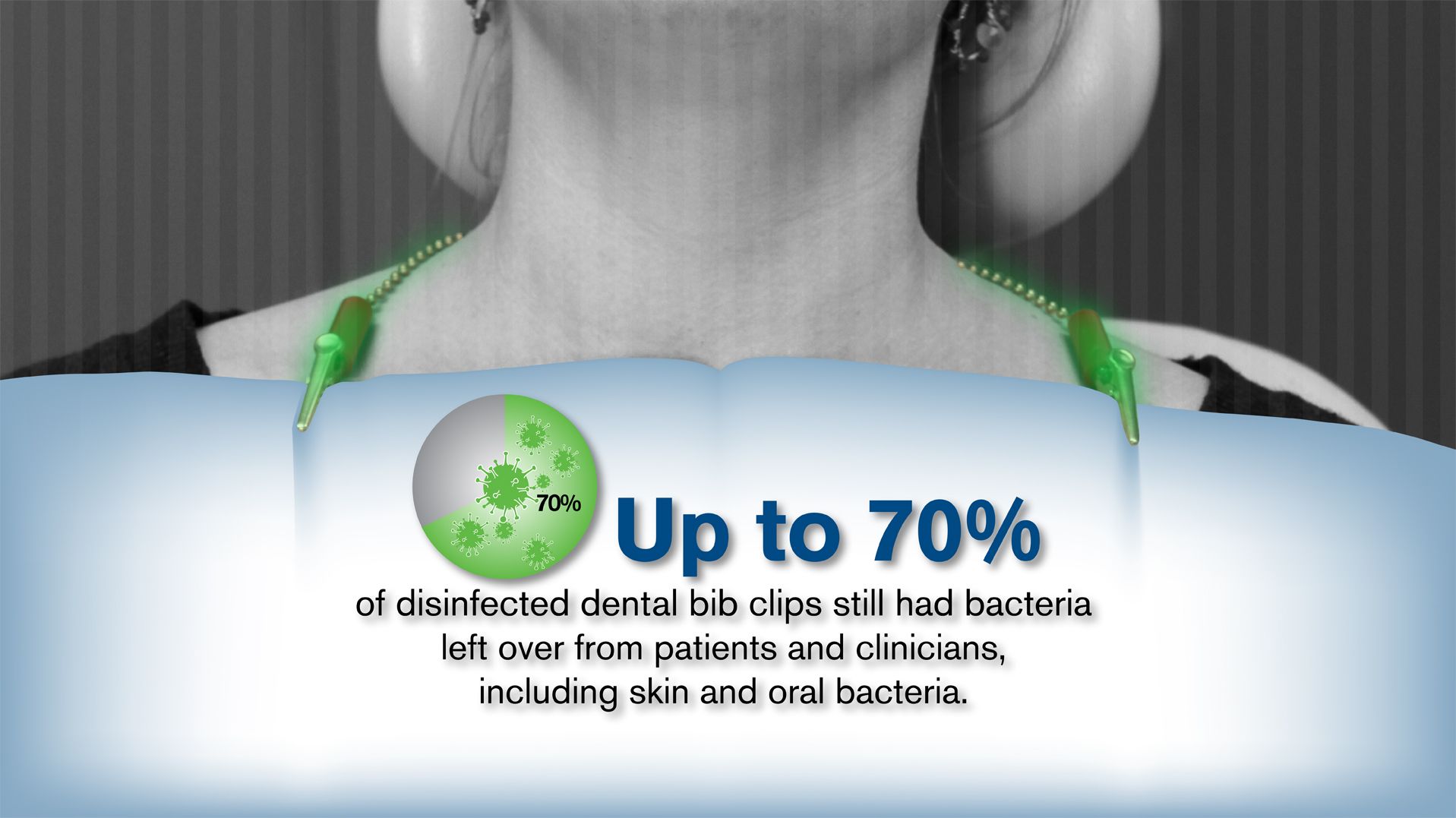Study: Dental bib clips can harbor oral bacteria even after disinfection
Researchers at Tufts University School of Dental Medicine and the Forsyth Institute published a study this week that found that a significant proportion of dental bib clips harbored bacteria from the patient, dental clinician and the environment even after the clips had undergone standard disinfection procedures in a hygiene clinic.
Researchers at Tufts University School of Dental Medicine and the Forsyth Institute published a study this week that found that a significant proportion of dental bib clips harbored bacteria from the patient, dental clinician and the environment even after the clips had undergone standard disinfection procedures in a hygiene clinic.
Although the majority of the thousands of bacteria found on the bib clips immediately after treatment were adequately eliminated through the disinfection procedure, the researchers found that 40% of the bib clips tested post-disinfection retained one or more aerobic bacteria, which can survive and grow in oxygenated environments.
They found that 70% of bib clips tested post-disinfection retained one or more anaerobic bacteria, which do not live or grow in the presence of oxygen.
The full study titled “Comprehensive Analysis of Aerobic and Anaerobic Bacteria Found on Dental Bib Clips at Hygiene Clinic” will be published as a supplement to the April issue of Compendium of Continuing Education in Dentistry, one of the leading dental journals in the U.S., and is now available for download at www.dentalbibclipbacteria.com.
“The study of bib clips from the hygiene clinic demonstrates that with the current disinfection protocol, specific aerobic and anaerobic bacteria can remain viable on the surfaces of bib clips immediately after disinfection,” said Addy Alt-Holland, M.Sc., Ph.D., Assistant Professor at the Department of Endodontics at Tufts University School of Dental Medicine and the lead researcher on the study.
“Although actual transmission to patients was not demonstrated, some of the ubiquitous bacteria found may potentially become opportunistic pathogens in appropriate physical conditions, such as in susceptible patients or clinicians.”
The study analyzed the clips on 20 dental bib holders after they had been used on patients treated in a dental hygiene clinic. The bib clips were sampled for aerobic and anaerobic bacterial contaminants immediately after treatment (post-treatment clips) and again after the clips were cleaned using disinfecting, alcohol-containing wipes (post-disinfection clips) according to the manufacturer instructions and the clinic’s disinfection protocol.
Led by Dr. Bruce Paster, Chair of the Department of Microbiology at the Forsyth Institute, microbiologists at the Forsyth Institute used standard molecular identification techniques and a proprietary, one-of-a-kind technology that can detect 300 of the most prevalent oral bacteria, to analyze the sampled bacteria from the bib clips. The analyses found:
- Immediately after treatment and before the clips had been disinfected, oral bacteria often associated with chronic and refractory periodontitis were found on 65% of the clips.
- After disinfection, three of the bib clips (15%) still had anaerobic Streptococcus bacteria from the oral cavity and upper respiratory tract. Five percent (5%) of the clips still harbored at least one bacteria from the Staphylococcus, Prevotella and Neisseria species.
- Additionally, after disinfection, nine clips (45%) retained at least one anaerobic bacterial isolate from skin.
“The results of our analysis show that there is indeed a risk of cross-contamination from dental bib clips. The previous patient’s oral bacteria could potentially still be on the clip and the new patient has a chance of being exposed to infection by using that same bib clip,” said Dr. Paster. “It is important to the clinician and the patient that the dental environment be as sterile as possible; thus it’s concerning that we found bacteria on the clips after disinfection. This situation can be avoided by thoroughly sterilizing the clips between each patient or by using disposable bib holders.”
Researchers involved in the study hypothesized that bacteria found on bib clips after patient care could have been transferred from patients and clinicians to the clips in different ways:
- Oral bacteria present in the patient’s saliva and the spray or spatter produced during dental treatments may contribute to the presence of bacteria on the disinfected bib clips.
- Bacteria can also be transferred from the gloved hands of dental practitioners to the clips prior to- or during the patient’s treatment.
- Bacteria can be transferred from the patient’s hands to the clips if the patient touches the clip.
In a previous study published in August 2012 by researchers at Tufts University School of Dental Medicine and the Forsyth Institute it was found that 20% to 30% of dental bib clips still harbor aerobic bacterial contaminants even after proper disinfection procedures.
Rubber-faced metal bib clips were found to retain more bacteria than bib clips made only of metal immediately after treatment and before disinfection. Four other research reports have found bacterial contamination on dental bib holders, including research conducted by U.S. infection control specialist Dr. John Molinari, the University of North Carolina at Chapel Hill’s School of Dentistry Oral Microbiology lab and the University of Witten/Herdecke in Germany.
Visit www.dentalbibclipbacteria.com to download a full transcript of the research paper “Comprehensive Analysis of Aerobic and Anaerobic Bacteria Found on Dental Bib Clips at Hygiene Clinic”, a supplement to the Compendium of Continuing Education in Dentistry Volume 34, Number 4, 2013.
The authors of the study include: Addy Alt-Holland, BSC, MSC, PhD; Christina M. Murphy, BS; Anne Powers, RDH; Claire L. Kublin, BS; Youjin Natalie Jeong, DMD; Michelle DiMattia; Linh Pham; Angel Park, MS, MPH; Matthew Finkelman, PhD; Maureen Lombard, RDH, MM; James B. Hanley, DMD; Bruce J. Paster, PhD; and Gerard Kugel, DMD, PhD.
How Dentists Can Help Patients Navigate Unforeseen Dental Care
December 12th 2024Practices must equip patients with treatment information and discuss potential financing options before unexpected dental treatments become too big of an obstacle and to help them avoid the risk of more costly and invasive procedures in the future.

